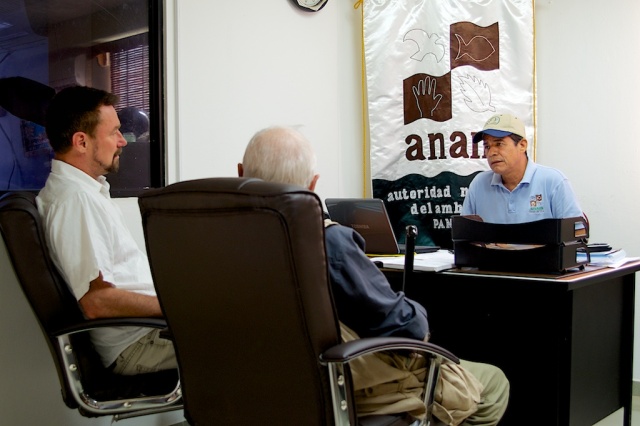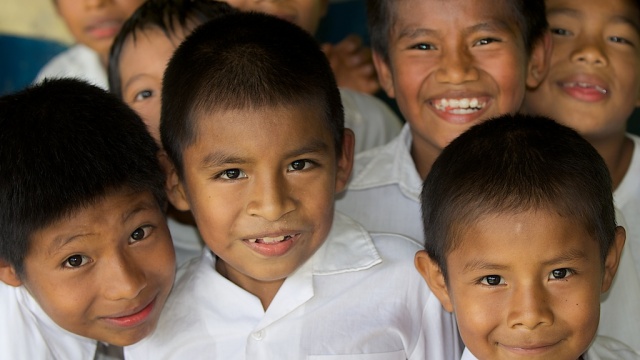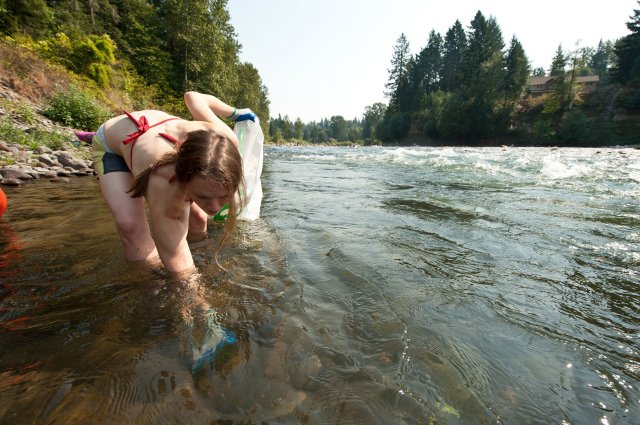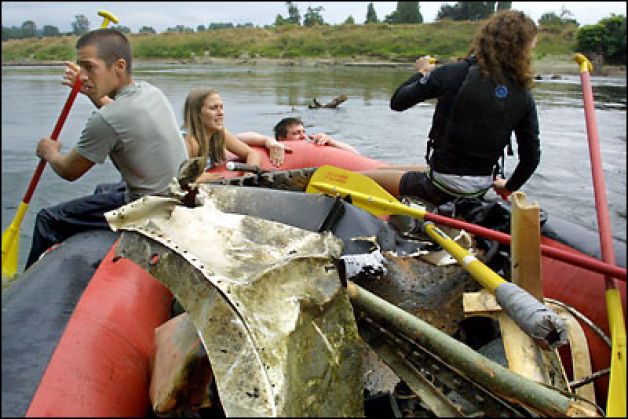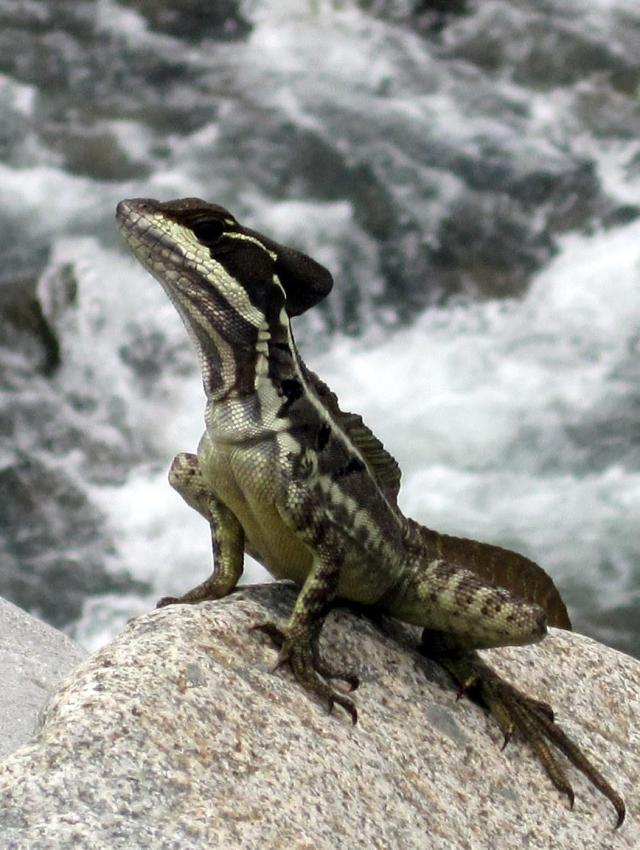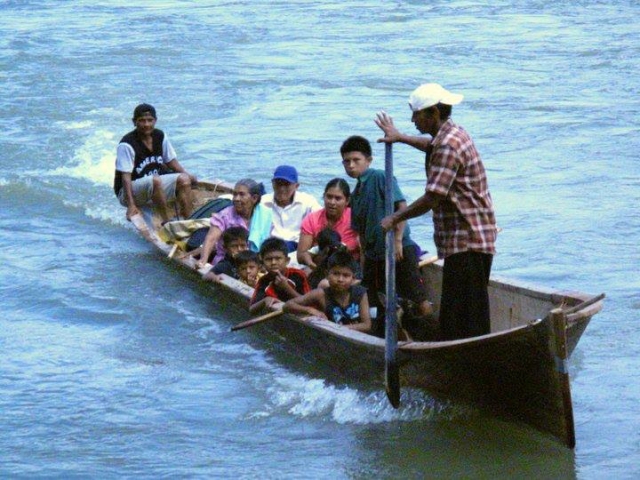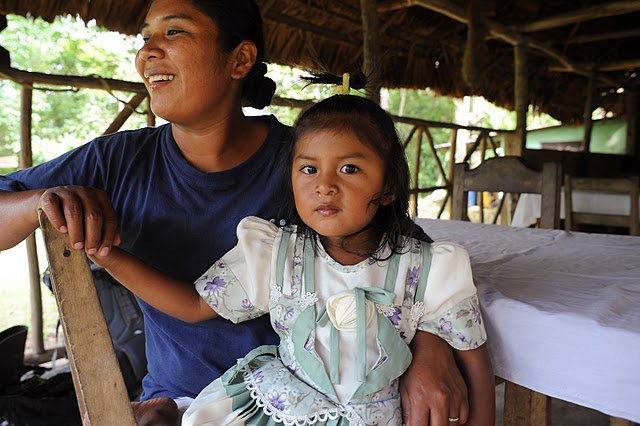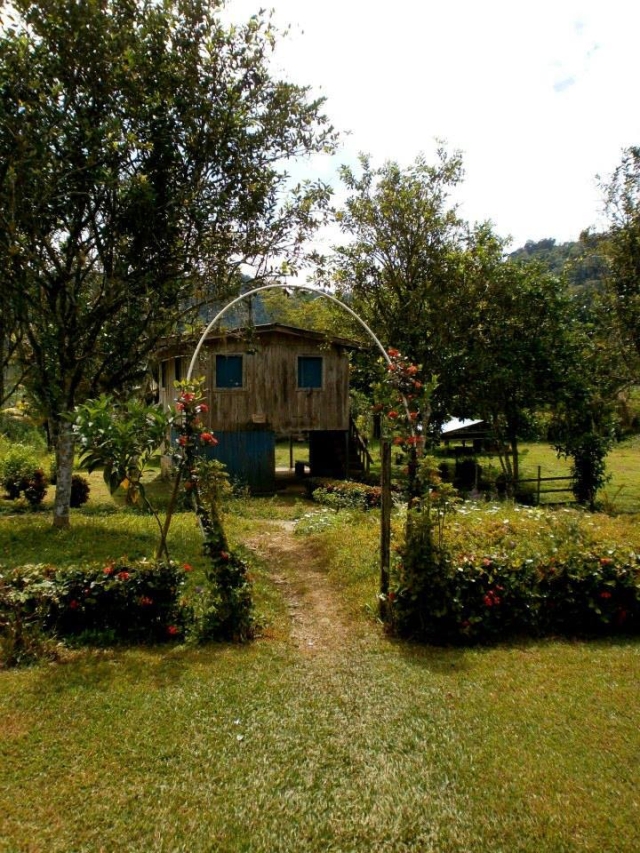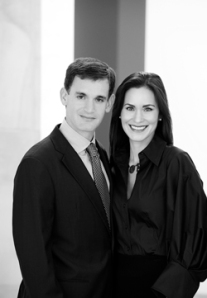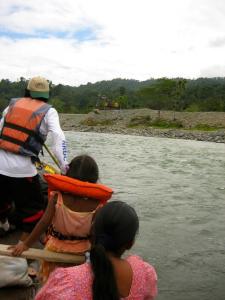This month in Central America we are subtitling interviews to produce a short news video in advance of filming the documentary ‘Grandmother Water’ in September. We are working to help the Naso give voice to their struggle, to introduce viewers to their goddess, Grandmother Water, “Tjër Di” in their language. We were surprised to learn that our first translator summarized the interviews. While we’re working on a full translation for the video, here are Mimi’s summaries to update our fellow supporters.

Naso students and families commuting on their Rio Teribe
INTERVIEW #1:
Steve: We are here at Wekso, the Naso Eco lodge, with Edwin Sanchez, an ODESEN leader. (Organization for the Development of Sustainable Eco-tourism for the Naso) Sr. Sanchez, please share with us your experience with ODESEN…
Edwin: I have been working 12 years for the development of eco-tourism. When I started working at Wekso, I was very young, shy and didn’t speak Spanish very well, but I learned from our visitors. This organization has been very beneficial for our community because it has generated many jobs for our people. It has also given us opportunities to better ourselves. Visitors have also donated many things for our community.
Steve: I understand that lately, along with ODESEN, you’ve done some work for the hydroelectric consortium. How did that experience compare with ODESEN?
Edwin: The government has been trying to convince authorities in our community about the benefits. There has been opposition to the building of hydroelectric projects in Naso territory. Complaints have been made with the Inter-American Commission on Human Rights.
Jobs are positive, but the project gives temporary jobs, it is not really acceptable because it is not being done the proper way. We see jobs that last for only 45 days; after that the person is laid off. And we see that there are a lot of external influences in this project, leaving us behind.
In the negative, we can see in the Bonjic community areas with families that live in huts or homes built by the hydroelectric project, but at the same time these people are left with no drinking water or secure electricity. Unfortunately these are the consequences of these projects. If more of the proposed hydroelectric projects are built it becomes a big threat for Naso people, because it destroys our culture, our river, our way of life.
Steve: If you have just one question you’d like your new king to address, what would it be?
Edwin: I would ask about the changes he was going to make for this community. Rey Alexis convinced us that he was going to help us but we have not seen anything come to fruition, nothing in writing for the Naso Comarca. Promises are not being kept and the company is expanding in our territory. What our ancestors left us is going to be lost. They left us this land for us to care for. We expect our King to give us the support we deserve.
Steve: What can be done to change this situation?
Edwin: There is no one to go out and fight for us, this is something we have to find for ourselves. We see many of these candidates on television who say they want to support our community, but we no longer believe in them.
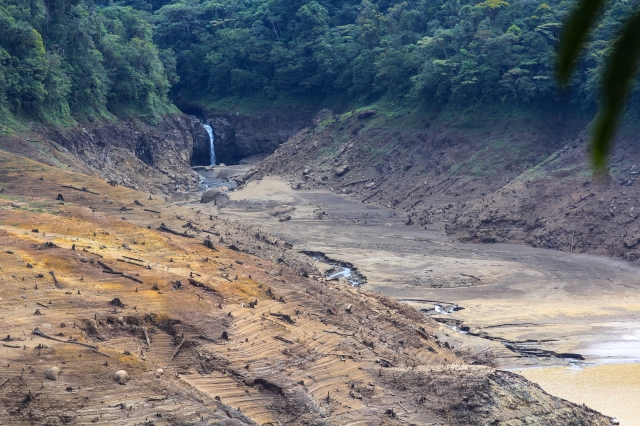
How the Fortuna hydroelectric consortium AES left a neighboring river.
INTERVIEW #2
Steve: Meet Adolfo Villagra, ODESEN Leader. Sr. Villagra, please share the background of the current Naso struggle…
Adolfo: In 1995 the Panamanian manager of the Bonjic project negotiated with EPM of Colombia to launch the project based on previous studies, but the Naso rejected the project. The former Naso King, Rey Tito Santana won the elections in 1999 and allowed additional studies to be undertaken along with the king who preceded him, Rey Cesar Santana… only to make studies of the Bonjic, Shey, and Teribe rivers.
The people did not authorize Tito to develop the project. However, in 2004, this King signed to develop the first of three proposed hydroelectric projects against the will of his people. He was overthrown and lived in exile as the Naso chose a new king, Rey Valentin. Panama’s government would not recognize Rey Valentin because he respected the will of the people.
In 2011 the government needed to negotiate the placement of transmission lines in Naso territory, and they finally admitted they were not negotiating with the true king chosen by the people, but they refused to recognize Valentin, again because he would not tell them what they wanted to hear. So they asked us to choose a new king. The people chose Rey Alexis Santana because he had opposed selling our rivers from the beginning.
By the time Alexis Santana and his team were selected by the community, the first project had been performed and it is a disappointment to the community due to many deceptions. The Naso people disagree with hydroelectric. They never agreed with the execution of the project. The former king did not fight for the rights of the region but for his own gain.
Now that the Kings have made business with the Panamanian government, they receive a compensation of $8 million over 20 years. The Naso have no law to negotiate benefits that would be more equitable. King Tito’s government received only $300,000 for the compensation plan for Naso community, in the form of development. But they build a road that goes only to their project on the Rio Bonjic and call it development for the Naso. The road doesn’t even go to the Bonjic community.
From 1997 to 2011, I was President of the NASO board. We worried about the impact caused by hydroelectric projects on our rivers, mountains, animals, people and the economy of the Naso people. Now we know the impact and reject again these destructive projects in our territory.
Steve: What is next?
Adolfo: It’s a difficult situation because we could not stop the Rio Bonjic project. They now expect to do more work on Rio Teribe that would end the rights of the Naso population. Today they are announcing another project, on the Rio Shey, another tributary of Teribe. We have been trying to get information about this but the company and the government are keeping it secret. We have not had access to any information about this project, a major project proposed in our territory.
These projects in no way benefit our community. We have no choice but to oppose more development of this type in our community. We have always said: “Over our dead bodies, if we have to shed blood and fight so the Naso people do not lose their river, we will”. We’ll do what it takes to maintain our ancestral territory, rivers and watershed.
We need the authorities to understand that the mission of the Naso community is to maintain the environment, culture, and that which feeds our people. We have been waiting for over 40 years for legal recognition of our human rights and autonomy for our land. The Panamanian government opposes it because economic interests favor the rich in the government. But we will not rest until the Naso community has a Comarca just like the other five indigenous groups in Panama, the Ngobe, Bugle, Embera, Wounaan, Kuna.
Steve: Why would a nation that has admirably recognized the rights of every other indigenous group within its borders deny the Naso the same rights?
Adolfo: We are being discriminated against. At a meeting of the IACHR leadership in Washington DC, the Panamanian government said that the Naso people have too small a population with only 4,000 inhabitants. But the government will not give us our land for political reasons.
Tito Santana made a bill creating the Comarca Naso. It failed in the National Assembly by just two votes. Then Tito began working with the hydroelectric project and the Comarca was forgotten until now. Alexis Santana has been in office for two years, but there is no evidence, nothing in writing, to show that he is honoring the will of our people. As a result our fight has been futile. The Naso people have been refused Comarca status due to interests in the commercial potential of our rivers.
Steve: It seems odd that this is happening in a Forest Reserve, International Park, a Biosphere Preserve recognized as an UNESCO World Heritage Site. What would you say to those who are supposed to be protecting these resources in your ancestral territory?
Adolfo: The Bonjic & Shey Rivers are at the edge of the international park in a buffer zone called the Palo Seco Forest Reserve. They feed the Rio Teribe, a river born in the park on the Costa Rica border. They are part of the La Amistad watershed. Why are they building hydroelectric projects if this is part of our heritage? We now have dead fish floating downriver from the Rio Bonjic, in a forest preserve. Why aren’t the institutions created for the conservation of the environment doing anything?

Like “clean coal” this is propaganda to push through privatization of public resources. Such projects lead to cascading ecosystem failure upriver and downriver. Water that nourished the cloud forest for centuries is now being lost to evaporation in this reservoir, as a once-riparian valley experiences desertification.
INTERVIEW #3
Steve: I am here with Rufina Santana, a member of the Naso Monarchy’s ruling family. Sra. Santana, what is the political situation with the project on the Rio Bonjic?
Rufina: For now the river has a good flow and is running smoothly. But as they make roads through (video shows tractors and trucks in the river) this affects us. We get out drinking water from this river. We use it for washing our clothing. People living in Changuinola also drink the water. It is not that we don’t want any development in our community. We want to move forward, we want our children to have an education; however we need to leave our river as God gave it to us, clean and crystalline.
The companies came on our land without consulting us during the reign of Tito Santana, who is my cousin. We have rights, but the government does not take them into account. They overlook our rights. They just don’t care. Many members of the community have taken to the streets and staged strikes (protest photos) yet the government invades our land. We are willing to fight for our rights so long as we are alive. They are no good if we are dead, are they?
Steve: You lead a group called APUD (Agricultural Producers United). How do Naso producers feel about the current struggle?
Rufina: In this group a team of producers form the board of directors but we work independently. We meet with beans, cocoa, oranges. We now have dryers to dry the cocoa, with this a lot of producers are happy – the cocoa dries better and it’s cleaner. Before we had other methods for this, we had to deal with a lot of setbacks. Each producer has its dryer now this benefits our harvest.
Steve: Are they ready for autonomy?
Rufina: This is the struggle always. This is not a struggle for Alexis Santana only. When I was Queen we also fought for this. We marked the trees with some red paint so others would know that this was our territory. We were doing what we could to mark the boundaries of our community. My dad, may he rest in peace, and my grandparents also fought for our rights. Still we have not achieved our independence. Just as other indigenous have their autonomous regions, we want ours. We have our own language, origins, songs, culture. We don’t want to live in collectiveness, we want our Comarca. We’ve asked every administration that comes to power to give us our shrine.

The Naso hope to stop their ancestral river from being squeezed for corporate gain. They see her as their mystical goddess “Grandmother Water”, she who nurtures Mother Earth who provides for us all.
INTERVIEW # 4
Steve: Sr. Guevarra administers the Naso’s legal documents. Thank you Sr. Guevara for your time. Three questions. Can you update us on the documentation from the Inter-American Commission on Human Rights (IACHR) in Washington DC.
Luis: Thanks for the interview, my name is Luis Guevarra, I am from the Naso territory, which is located within the La Amistad International Park. Most of our inhabitants live in a place called the Palo Seco Forest Reserve. The villages have been fighting for 40 years. Every government that comes along refuses to take seriously the Naso’s rights to their territory.
We presented the facts that occurred from 2004 to 2009 to the IACHR in a petition made by the Naso people. Unfortunately the government is providing false documentation. For this reason the Commission has been unable to decide anything for the Naso. Our own authorities have been manipulated and our demands forgotten.
Steve: Rey Alexis Santana told me in an interview that he was working on the Naso Comarca, that it was his top goal. What does Panama’s National Assembly say about this?
Luis: In November I was with the Commission of Indigenous Affairs in Panama . They said that no authority has ever submitted any petition for the region for the law creating the Naso County 19. I asked what was the political status of the indigenous territory. They said the Naso leadership and King Alexis Santana at no time talked about the region with them. They said no one has come to inquire about the matter. According to them there are no developments and, if they handed the territory over to the Naso, we wouldn’t know how to manage it.
Steve: But the Naso have managed it sustainably for more than 1,000 years, their ancestral territory, and were recognized in the binational application to the United Nations for a World Heritage Site as excellent stewards of the regions’s forest and rivers. What would you say to those suggesting that you don’t know how to manage your territory as they permit the dynamiting of your rivers, the clear cutting your forests, and the bulldozing of your shoreline?
Luis: The hydroelectric project within the Naso community is illegal. They have not consulted with us and they do not have our approval. They are operating illegally. At first the government said that this project was for an expanded population. However, the government continues to exploit our natural resources for private profit. This is the reason they have no interest in creating a Comarca. This has divided the Naso people into two camps. There is a minority who are paid by the companies to support the project. The majority of us will fight for our region.
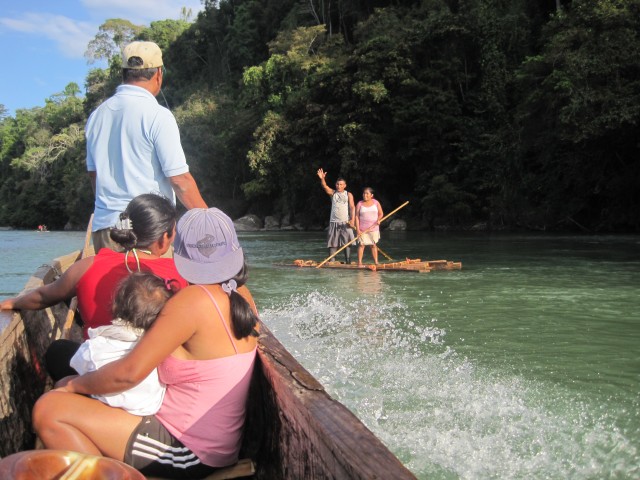
This story examines the need for development versus the need for conservation of watershed ecology, the priorities of consumer cultures versus the priorities of sustainable cultures.
Thanks to Cinematographer Aaron Lawler for these photos, Director Ed Gish, Philanthropist Jennifer Long for fundraising, and everyone helping produce this video news short.
For more details, or to support this effort with a tax-deductible contribution to the Big River Foundation visit us at Indiegogo. We also have volunteer opportunities in paradise.
“In the end, we conserve only what we love; we love only what we understand; and we understand only what we have been taught.” – Baba Dioum, Founder, International Union for the Conservation of Nature





